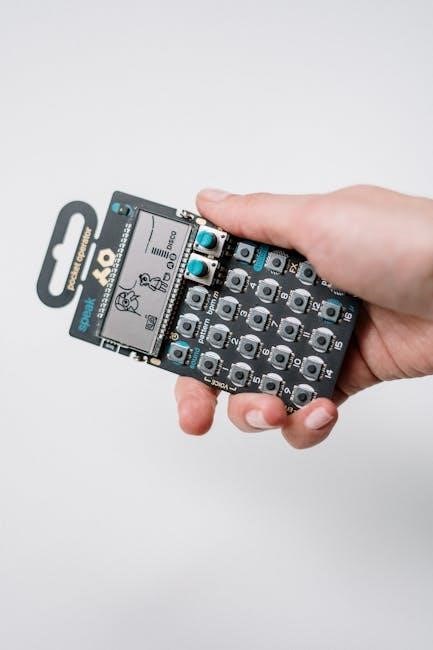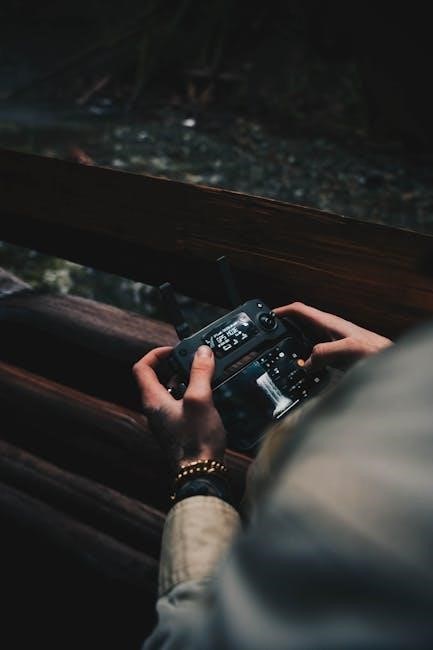BI LOC8 XT User Manual: Comprehensive Guide
The BI LOC8 XT user manual offers a comprehensive guide to understanding and utilizing the ankle-mounted GPS tracking device. This manual details features, setup, and troubleshooting for optimized monitoring. It ensures that users can effectively manage and interpret data gathered by the device.
Overview of the BI LOC8 XT
The BI LOC8 XT is a single-piece, ankle-mounted GPS tracking device designed for reliable offender monitoring. It uses GPS, Wi-Fi, and cellular technology to provide location data. This device is intended for individuals under supervision by law enforcement or court order, offering a discreet and efficient method for tracking community movement. The low-profile, curved design ensures the ankle bracelet is form-fitting and less obtrusive, promoting client compliance and comfort.
The BI LOC8 XT is engineered for long-term use, featuring an extended battery life of up to 60 hours on a single charge. The device records location points frequently, ensuring near real-time tracking capabilities. It’s equipped with advanced GPS technology, including Assisted GPS, which enhances location accuracy.

The intuitive monitoring software, designed for community correction officers, simplifies the process of monitoring compliance. The BI TotalAccess software platform is user-friendly, making it easy to learn and operate. The BI LOC8 XT is waterproof, providing durability and reliability in various environmental conditions, and is designed to stay connected.

Key Features and Benefits
The BI LOC8 XT offers several key features and benefits for effective offender monitoring. Its primary function is to provide real-time location tracking through GPS, Wi-Fi, and cellular technologies, ensuring continuous monitoring and compliance. The extended battery life, offering up to 60 hours on a single charge, minimizes the need for frequent charging and ensures uninterrupted tracking.
The device’s low-profile, ankle-bracelet design is discreet and comfortable for the wearer, promoting better compliance. Its waterproof construction ensures durability and reliability in various environments. The BI LOC8 XT also incorporates assisted GPS (A-GPS) for enhanced location accuracy, providing more precise data for monitoring purposes.
One of the significant benefits is the integration with the BI TotalAccess software platform, designed for ease of use by community correction officers. This software simplifies the monitoring process, making it easier to learn and operate. The device’s ability to record location points frequently allows for near real-time tracking, which is crucial for effective supervision and rapid response to potential violations. The BI LOC8 XT helps clients stay connected and compliant, facilitating successful reintegration into the community.
Device Components and Functionality
The BI LOC8 XT is a single-piece, ankle-mounted device integrating several key components for comprehensive tracking. At its core, the device includes a GPS module for satellite-based location tracking, complemented by Wi-Fi and cellular connectivity to enhance location accuracy and ensure continuous monitoring even in areas with limited GPS coverage. The device incorporates a non-removable, extended-life battery, providing up to 60 hours of operation on a single charge.
Functionally, the BI LOC8 XT operates by continuously searching for and recording location fixes multiple times per minute, storing the best point every minute. The integrated GPS technology includes assisted GPS (A-GPS) to improve the speed and accuracy of location acquisition. The device’s waterproof design ensures reliable performance in various environmental conditions, while its tamper-resistant construction prevents unauthorized removal or interference.
The BI LOC8 XT is designed to seamlessly integrate with the BI TotalAccess software platform, allowing officers to monitor compliance effectively. The device also features LED indicators to display battery status and connectivity, providing immediate feedback on its operational status. The data collected is transmitted securely to the monitoring center for analysis and reporting, ensuring reliable and accurate tracking information.
Initial Setup and Activation
The initial setup of the BI LOC8 XT involves a straightforward activation process to ensure proper functionality. Upon receiving the device, verify that all components are included and undamaged. The first step is to charge the device fully using the provided charging equipment. Connect the charger to a power source and attach it to the BI LOC8 XT until the battery indicator shows a full charge.
Once charged, the device needs to be activated through the BI TotalAccess software platform. Log in to the platform using your credentials and navigate to the device activation section. Enter the unique identifier or serial number of the BI LOC8 XT, which can be found on the device itself or its packaging. Follow the on-screen prompts to link the device to the appropriate user profile and monitoring parameters.
During the activation process, configure the device settings according to the specific monitoring requirements. This may include setting up geofences, defining exclusion zones, and adjusting the frequency of location updates. After configuring these settings, confirm the activation to finalize the setup. It is essential to perform a test run to ensure that the device is tracking and reporting locations accurately. Verify the data on the monitoring platform to confirm successful activation and proper functionality before deployment.
Wearing and Maintaining the Device
Proper wear and maintenance of the BI LOC8 XT are crucial for its optimal performance and longevity. The device should be securely fastened around the ankle, ensuring a snug but comfortable fit. The strap should not be too tight to avoid restricting circulation or causing skin irritation. Regularly check the strap for wear and tear, and replace it if any damage is observed.
To maintain the BI LOC8 XT, clean the device regularly with a soft, damp cloth. Avoid using harsh chemicals or abrasive cleaners, as these can damage the device’s casing and electronic components. Pay close attention to the charging port, ensuring it remains free of dirt and debris. Inspect the device for any signs of physical damage, such as cracks or loose parts.
When not in use, store the BI LOC8 XT in a cool, dry place away from direct sunlight and extreme temperatures. Avoid exposing the device to excessive moisture or humidity, as this can affect its internal components. It is important to follow the manufacturer’s guidelines for proper storage and handling to prevent damage and ensure the device remains in good working condition. Regular maintenance and careful handling will extend the lifespan of the BI LOC8 XT and ensure reliable performance.

Charging and Battery Information
The BI LOC8 XT features a non-removable battery, designed for extended performance and reliability. To ensure continuous operation, it is essential to adhere to the recommended charging procedures. The device can achieve up to 60 hours of performance on a single charge, depending on usage and network conditions. Regular charging is crucial for maintaining optimal battery health and preventing unexpected downtime.
To charge the BI LOC8 XT, connect the provided charger to a standard power outlet and attach it to the charging port on the device. Ensure the connection is secure and the charging indicator light illuminates, signaling that the device is charging. Allow the device to charge fully before disconnecting it. Avoid using third-party chargers, as they may not be compatible and could damage the battery or the device itself.
Monitor the battery level regularly to avoid complete discharge. Low battery alerts will notify users when charging is required. In cases where the device features a removable battery system, always ensure the battery is properly inserted and locked into place. Store spare batteries in a cool, dry place, and avoid exposing them to extreme temperatures. Following these guidelines will maximize battery life and ensure the BI LOC8 XT remains operational when needed.
Understanding Location Tracking Technology (GPS, Wi-Fi, Cellular)
The BI LOC8 XT employs a multi-faceted approach to location tracking, utilizing GPS, Wi-Fi, and cellular technology to provide accurate and reliable positioning data. GPS (Global Positioning System) relies on satellite signals to determine the device’s location, offering precise outdoor tracking capabilities. However, GPS signals can be obstructed indoors or in areas with limited sky view.

To enhance location accuracy in challenging environments, the BI LOC8 XT also incorporates Wi-Fi positioning. By detecting nearby Wi-Fi networks, the device can triangulate its position even without a direct GPS signal. This is particularly useful in urban areas with dense Wi-Fi coverage. Cellular technology provides a third layer of location tracking, using cell tower triangulation to estimate the device’s location. This method is less precise than GPS or Wi-Fi but serves as a backup when other signals are unavailable.
The BI LOC8 XT intelligently combines these three technologies to provide the most accurate location data possible. It prioritizes GPS when available, seamlessly switching to Wi-Fi or cellular when necessary. This integrated approach ensures continuous tracking, even in environments where a single technology might fail. Understanding how these technologies work together is crucial for interpreting the location data provided by the BI LOC8 XT.
Interpreting Monitoring Data
The BI LOC8 XT generates a wealth of monitoring data, which requires careful interpretation to effectively supervise individuals. Location points, recorded frequently, form the basis of the data. These points are displayed on a map, often integrated with Google Maps, allowing officers to visualize movement patterns and identify potential compliance issues. Understanding the frequency of location updates is crucial; more frequent updates provide a more detailed picture of movement.
Proximity alerts are another vital aspect of the data. These alerts are triggered when the device enters or exits pre-defined zones, such as exclusion or inclusion areas. Interpreting these alerts involves considering the context of the individual’s activities and any pre-approved schedules. For instance, an alert triggered during work hours at a designated work location might be expected, while an alert from an exclusion zone at night would warrant further investigation.
Furthermore, the data includes timestamps associated with each location point and alert. Analyzing these timestamps is essential for determining the timing of events and identifying any patterns of non-compliance. The BI TotalAccess software platform provides tools for filtering and analyzing this data, making it easier for officers to identify trends and anomalies. Effective interpretation of the monitoring data requires a combination of technical understanding and contextual awareness.
Troubleshooting Common Issues
The BI LOC8 XT, while reliable, may encounter occasional issues. A common problem is battery-related, such as the device not charging or the battery draining quickly. First, ensure the charging beacon is properly connected and functioning. If the battery still fails to charge, try a different outlet or charging beacon. For rapid battery drain, investigate potential causes, such as prolonged exposure to extreme temperatures or frequent loss of GPS signal, which forces the device to work harder to acquire location data.
Another frequent issue is loss of GPS signal. This can occur in areas with dense foliage, tall buildings, or underground locations. If the device consistently loses signal in a specific area, consider alternative tracking methods like Wi-Fi or cellular triangulation. If the signal loss is widespread, check the device’s settings to ensure GPS is enabled and functioning correctly. A device reset may also resolve this issue.
Alert malfunctions, such as alerts not triggering or false alerts, can also occur. Verify that the exclusion and inclusion zones are correctly configured in the monitoring software. Ensure the device has a stable GPS signal within the zones. If problems persist, contact BI Incorporated support for assistance. Regular maintenance and prompt attention to error messages can prevent many common issues.
Compliance and Safety Information
The BI LOC8 XT is designed with safety and compliance as paramount considerations. Users must adhere to all regulations set forth by supervising authorities and BI Incorporated. Tampering with the device, including attempts to disable or circumvent its tracking capabilities, is strictly prohibited and may result in legal consequences. Ensure the device remains securely fastened to the ankle and avoid any modifications that could compromise its functionality.
The device’s materials are selected to minimize skin irritation, but users should regularly inspect the attachment site for signs of discomfort or allergic reaction. If any irritation occurs, contact supervising personnel immediately. Avoid exposing the device to extreme temperatures or corrosive substances, as this may damage its components and affect its accuracy. Handle the device with care and follow all maintenance guidelines to ensure its longevity and performance.
The BI LOC8 XT complies with FCC regulations regarding radio frequency emissions. However, users should maintain a reasonable distance from other electronic devices to prevent interference. Any unauthorized modifications to the device’s hardware or software may void its compliance and warranty. Always consult the user manual and seek guidance from authorized personnel if you have questions regarding compliance or safety protocols. This ensures responsible and safe operation of the BI LOC8 XT.
Contacting Support
For any inquiries, technical assistance, or to report issues related to the BI LOC8 XT, several support channels are available. The primary point of contact for device-related concerns is typically the supervising authority or agency responsible for monitoring. They can provide initial troubleshooting steps and guidance based on specific circumstances. Contact information for the supervising agency should be readily accessible in provided documentation or through prior communication.
In situations requiring more specialized technical support, BI Incorporated offers direct assistance; Refer to the user manual for the most up-to-date contact details, including phone numbers and email addresses. When contacting BI Incorporated, be prepared to provide the device’s serial number, a detailed description of the issue, and any relevant information that may aid in diagnosis. Response times may vary depending on the nature of the inquiry and support availability.
Additionally, an online knowledge base and frequently asked questions (FAQ) section may be available on the BI Incorporated website. These resources can provide quick answers to common questions and offer self-service troubleshooting tips. Remember to clearly articulate the problem and provide all necessary details when seeking support to ensure efficient and effective resolution. Utilizing available resources and maintaining clear communication will expedite the support process and minimize any disruption in device operation.
